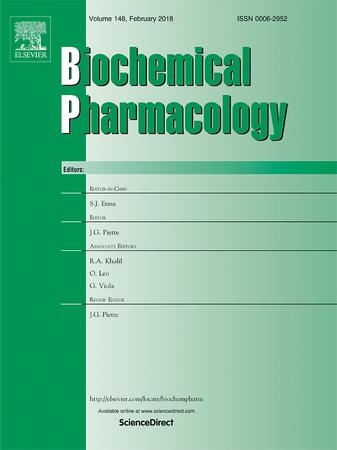Isatin ameliorates ovarian inflammation and apoptosis caused by hormonal imbalances in PCOS mice
IF 5.3
2区 医学
Q1 PHARMACOLOGY & PHARMACY
引用次数: 0
Abstract
Polycystic ovary syndrome (PCOS) is the most common reproductive endocrine disorder in women of childbearing age. Isatin (ISA) is a bioactive compound naturally found in mammalian body fluids and tissues, known for its potent antioxidant, anti-inflammatory, and anticancer properties. We used letrozole to induce a PCOS mouse model and evaluated the reproductive benefits of ISA. The mice were initially grouped according to the concentration of ISA administered at 25, 50, and 100 mg/kg. Subsequently, research results indicated that the optimal concentration was determined to be 100 mg/kg, while a positive control group was established using 150 mg/kg of metformin. The results demonstrated that PCOS mice exhibited obesity, disrupted estrous cycles, polycystic ovaries, insulin resistance, disruption of cytoskeletal structure, mitochondrial damage and decreased fertility. Additionally, the elevated androgen levels in PCOS mice also led to ovarian inflammation, oxidative stress, and apoptosis. However, ISA effectively reversed these damages. High-throughput sequencing revealed that ISA significantly downregulated the expression of genes related to androgen production, including STAR, CYP11A1 and CYP17A1. ISA can also reduce the expression of pro-inflammatory factors and inhibit the activation of the NF-κB pathway, thereby alleviating ovarian inflammation. Post-treatment with ISA resulted in reduced levels of ROS and MDA, and inhibited apoptosis in the ovarian tissue of PCOS mice by modulating apoptosis related proteins, such as BAX, P53, BCL-2, and Caspase-3. In summary, a protective effect of ISA on the ovaries in the letrozole-induced PCOS mouse model was demonstrated by regulating hormone secretion, alleviating inflammation and oxidative stress, and subsequently inhibiting ovarian cell apoptosis.

Isatin改善PCOS小鼠激素失衡引起的卵巢炎症和细胞凋亡
多囊卵巢综合征(PCOS)是育龄妇女最常见的生殖内分泌疾病。Isatin (ISA)是一种天然存在于哺乳动物体液和组织中的生物活性化合物,以其有效的抗氧化、抗炎和抗癌特性而闻名。我们用来曲唑诱导PCOS小鼠模型,并评估ISA的生殖效益。小鼠按25、50、100 mg/kg给药剂量分组。随后,研究结果确定最佳浓度为100 mg/kg,以150 mg/kg二甲双胍为阳性对照组。结果表明,PCOS小鼠表现为肥胖、动情周期中断、多囊卵巢、胰岛素抵抗、细胞骨架结构破坏、线粒体损伤和生育能力下降。此外,PCOS小鼠雄激素水平升高还会导致卵巢炎症、氧化应激和细胞凋亡。然而,ISA有效地扭转了这些损害。高通量测序结果显示,ISA显著下调了雄激素产生相关基因STAR、CYP11A1和CYP17A1的表达。ISA还能降低促炎因子的表达,抑制NF-κB通路的激活,从而减轻卵巢炎症。ISA处理后可降低PCOS小鼠卵巢组织的ROS和MDA水平,并通过调节BAX、P53、BCL-2和Caspase-3等凋亡相关蛋白抑制PCOS小鼠卵巢组织的凋亡。综上所述,在来曲唑诱导的PCOS小鼠模型中,ISA通过调节激素分泌,减轻炎症和氧化应激,进而抑制卵巢细胞凋亡,对卵巢具有保护作用。
本文章由计算机程序翻译,如有差异,请以英文原文为准。
求助全文
约1分钟内获得全文
求助全文
来源期刊

Biochemical pharmacology
医学-药学
CiteScore
10.30
自引率
1.70%
发文量
420
审稿时长
17 days
期刊介绍:
Biochemical Pharmacology publishes original research findings, Commentaries and review articles related to the elucidation of cellular and tissue function(s) at the biochemical and molecular levels, the modification of cellular phenotype(s) by genetic, transcriptional/translational or drug/compound-induced modifications, as well as the pharmacodynamics and pharmacokinetics of xenobiotics and drugs, the latter including both small molecules and biologics.
The journal''s target audience includes scientists engaged in the identification and study of the mechanisms of action of xenobiotics, biologics and drugs and in the drug discovery and development process.
All areas of cellular biology and cellular, tissue/organ and whole animal pharmacology fall within the scope of the journal. Drug classes covered include anti-infectives, anti-inflammatory agents, chemotherapeutics, cardiovascular, endocrinological, immunological, metabolic, neurological and psychiatric drugs, as well as research on drug metabolism and kinetics. While medicinal chemistry is a topic of complimentary interest, manuscripts in this area must contain sufficient biological data to characterize pharmacologically the compounds reported. Submissions describing work focused predominately on chemical synthesis and molecular modeling will not be considered for review.
While particular emphasis is placed on reporting the results of molecular and biochemical studies, research involving the use of tissue and animal models of human pathophysiology and toxicology is of interest to the extent that it helps define drug mechanisms of action, safety and efficacy.
 求助内容:
求助内容: 应助结果提醒方式:
应助结果提醒方式:


